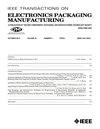Electrical Shorting Propensity of Tin Whiskers
IEEE Transactions on Electronics Packaging Manufacturing
Pub Date : 2010-07-26
DOI:10.1109/TEPM.2010.2053377
引用次数: 9
Abstract
When a tin whisker bridges two differently biased conductors, an electrical short is not guaranteed. In many instances, the voltage must exceed a threshold level in order to produce current flow due to weak physical contact and the presence of a non-conductive film such as an oxide layer. This paper presents a study that examines the breakdown voltage of tin whiskers and its relation to contact force. Whisker contact force studies were conducted using gold- and tin-coated tungsten probes, and the breakdown voltage was measured using a semiconductor parameter analyzer. It was verified that contact force is a critical factor in determining the type of current-voltage transition and level of breakdown voltage. Lower contact force between the probe and the whiskers caused the multiple transitions in current-voltage characteristics. The tin oxide layers on whiskers were analyzed using field emission transmission electron microscopy (FE-TEM).锡晶须的电短路倾向
当锡晶须桥接两个不同偏压的导体时,不能保证电短路。在许多情况下,由于弱物理接触和非导电膜(如氧化层)的存在,电压必须超过阈值水平才能产生电流。本文研究了锡晶须的击穿电压及其与接触力的关系。采用镀金和镀锡钨探针对晶须接触力进行了研究,并使用半导体参数分析仪测量了击穿电压。验证了接触力是决定电流-电压转换类型和击穿电压水平的关键因素。探针与晶须之间较低的接触力导致了电流-电压特性的多次转变。采用场发射透射电镜(FE-TEM)对晶须表面氧化锡层进行了分析。
本文章由计算机程序翻译,如有差异,请以英文原文为准。
求助全文
约1分钟内获得全文
求助全文

 求助内容:
求助内容: 应助结果提醒方式:
应助结果提醒方式:


